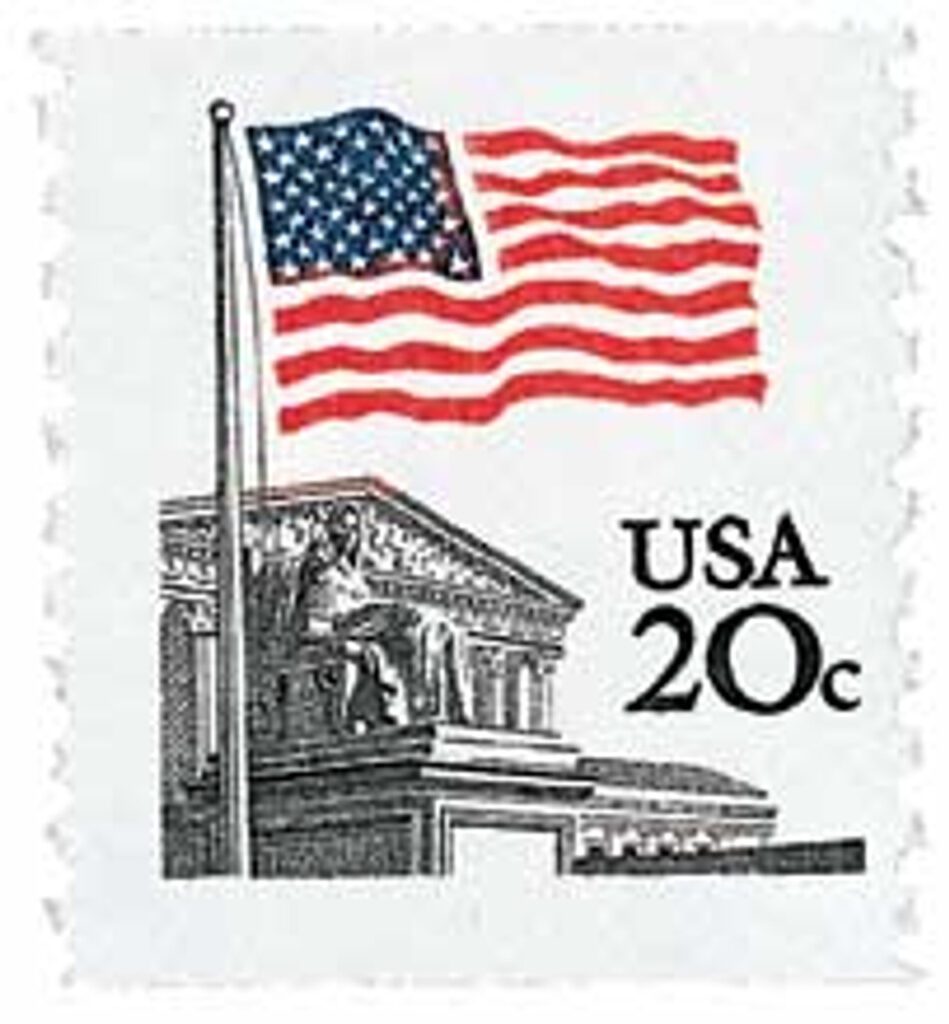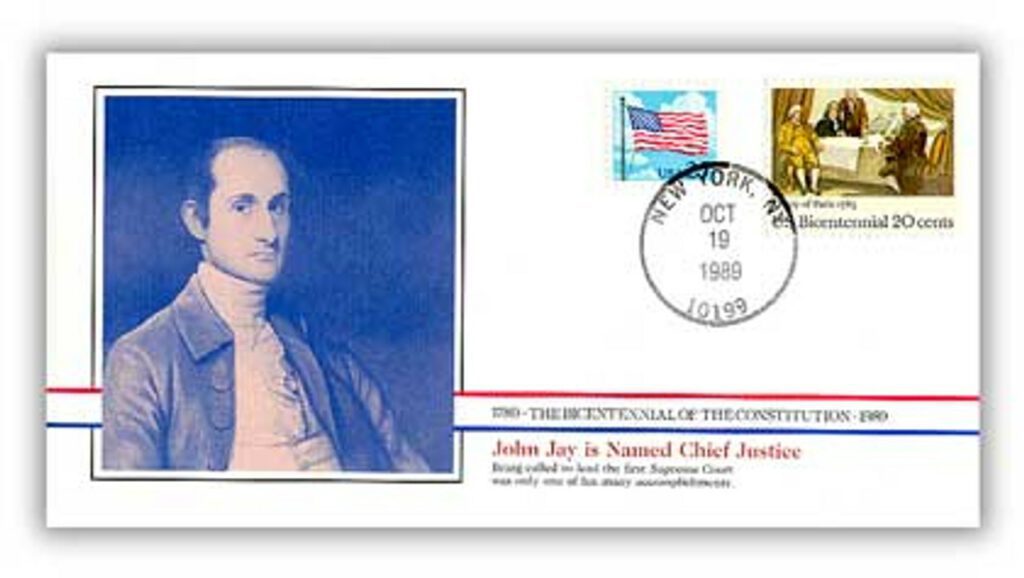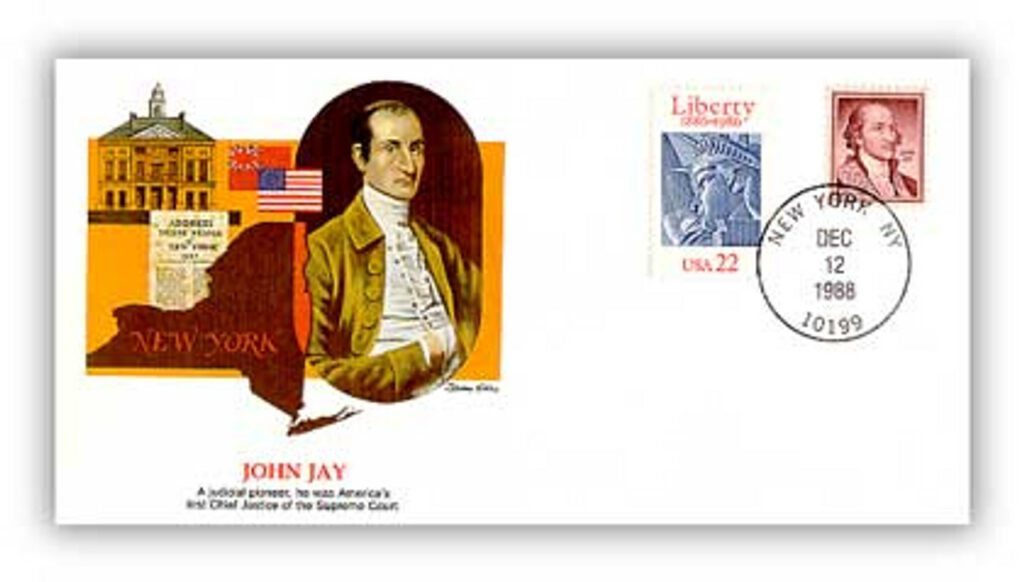
On October 19, 1789, John Jay was sworn in as the first chief justice of the Supreme Court of the United States, becoming the head of a new judicial branch that would help define the rule of law in the young country. Though the event was modest in ceremony, it marked the beginning of one of the most important institutions in American government.
John Jay was already one of America’s most accomplished Founding Fathers. Born in 1745 in New York City, he was educated at King’s College (now Columbia University) and quickly rose to prominence as a skilled lawyer and thoughtful statesman. Jay played a key role in the First and Second Continental Congresses, where he worked to defend colonial rights and later to help shape the new country. During the Revolutionary era, he helped draft New York’s first state constitution and served as the state’s chief justice of the Supreme Court of Judicature.
Jay’s abilities also earned him important diplomatic roles. He was appointed Ambassador to Spain in 1779, where he negotiated support for the American cause. Later, he joined Benjamin Franklin and John Adams in negotiating the Treaty of Paris (1783), the agreement that officially ended the American Revolution and secured recognition of the United States as an independent country.
After the war, Jay served as secretary of foreign affairs under the Articles of Confederation, essentially functioning as America’s top diplomat. He saw firsthand how weak the national government was under the Articles and became a strong advocate for a more unified, centralized federal system. His support for the new Constitution was unwavering, and he joined Alexander Hamilton and James Madison in writing the Federalist Papers—a series of essays arguing for the ratification of the US Constitution. Jay authored five of these essays, focusing on the importance of unity and the need for an independent judiciary to preserve justice and order.
When the Constitution was finally ratified in 1788, President George Washington faced the enormous task of building a government from scratch. Among his first responsibilities was appointing leaders to the major new offices. In September 1789, Washington offered Jay the post of secretary of state. Although the title was new, the position would have carried similar duties to those Jay already held as secretary of foreign affairs. Jay politely declined, perhaps seeking new challenges. Washington soon offered him another historic role—chief justice of the Supreme Court.

Washington described the position as “the keystone of our political fabric,” emphasizing how critical it would be to the country’s stability. Jay accepted, and on September 24, 1789, Washington officially nominated him. Two days later, the Senate unanimously confirmed him. On October 19, 1789, John Jay took the oath of office, becoming the first chief justice in US history.

In the early years, the Supreme Court’s work was very different from what we know today. For its first three years, much of the court’s time was spent creating rules, procedures, and traditions, as well as admitting lawyers to the bar and riding circuit—traveling around the country to preside over federal district court cases. Jay also used his time on the circuit to discuss constitutional ideas with local leaders and to strengthen public trust in the new federal government.

One of Jay’s most significant early actions came in 1790, when Treasury Secretary Alexander Hamilton asked the court to endorse legislation dealing with state debts. Jay firmly refused, stating that the Supreme Court could only decide actual cases brought before it—it could not issue political opinions or support legislation. This decision helped establish the independence of the judiciary, setting a crucial precedent that remains in place today.
During Jay’s six-year tenure as chief justice, the court heard only four major cases, but each helped define the scope of federal power and the balance between branches of government. In one case, the court ruled that the legislative and executive branches could not revise a judicial decision, reinforcing the separation of powers. In another, the justices declared that jurors had the authority to decide both questions of fact and law, clarifying the role of the jury system.
Perhaps the most notable case of Jay’s term involved whether a state—Georgia—could be sued by citizens of another state. The court ruled that it could, a decision that angered many states and led directly to the passage of the Eleventh Amendment, which limited such suits.

John Jay resigned from the Supreme Court in 1795 to become Governor of New York, continuing his lifelong service to the public. Yet his brief time as chief justice laid the foundation for the country’s highest court. By insisting on judicial independence, fairness, and constitutional boundaries, Jay helped define what justice would mean in the United States for centuries to come.
| FREE printable This Day in History album pages Download a PDF of today’s article. Get a binder or other supplies to create your This Day in History album. |
Discover what else happened on This Day in History.




Great article
Love these daily bits of history. Thanks for sending.
Seems like a very important person in the early times.
If no one brings the facts to surface they remain submerged. Thanks for your effort.
My daughter is using these posts as a basis for history lessons for her home-schooled kids. A side effect will be the introduction of two more kids into stamp collecting.
Always enjoy reading the History of the Day
I look forward to your email every day.
Nice story
And today’s Chief Justices are ruling on much more than a laws Constitutionality, but writing law themselves by denying Tenth Amendment states rights, as in the definition of marriage, abortion, etc.
Marriage and abortion are not rights. They are not defined in the Bill of Rights. If you want them as rights, then propose an Amendment to the Constitution. But, the federal government should not be involved in issues that the states rightly own.
Another interesting part of our History with stamps to enhance
that part of our History…I have been sending The Day to my
16 year old granddaughter and she tells me she is becoming more
interested in our history and wow!!!!….. likes the stamp info……. !!!!
In Dave’s comment (above), he above might want to look up Article VI of the U.S. Constitution which states in part, “This Constitution and the laws of the United States…shall be the supreme law of the land and the judges in every state shall be bound thereby, any thing in the constitutions or laws of any state to the contrary notwithstanding .”
When you look at the George Washington administration you realize that through his appointments and constituency our 1st president surrounded himself with what truly was the dream team. The article is about John Jay and mentions Alexander Hamilton, but the balance of the group known as “The Framers”(Jefferson, Madison, Monroe, Franklin et al) were all on board and would emerge individually as well.
October 19, 1781 British General Cornwallis surrendered his command to
the Continental Army effectively ending the Revolutionary War. His surrender
was the final act and the British Parliament had enough of the war. Less than two
years later the Treaty of Paris gave the Colonies their independence.
The most important case John Jay wrote as Chief Justice was Marburg v Madison. This established the Supreme Court’s ability to strike down actions and laws deemed to be unconstitutional setting the powers of the Supreme Court foe the next 200+ years
Marbury v Madison
That decision was in 1803 when John Marshall was Chief Justice.
Yes, Lord Cornwallis surrendered in Yorktown, Virginia. To Mr Richard
Messersmith. If I’m not mistaken, there was a German WWII fighter BF 262.
These fighter (aircraft) was the first jet fighter ever built. It is the prototype of all future fighters, from the Mig (Migoyan Gurevich), to the F16, F18, etc.